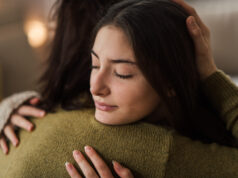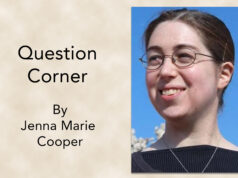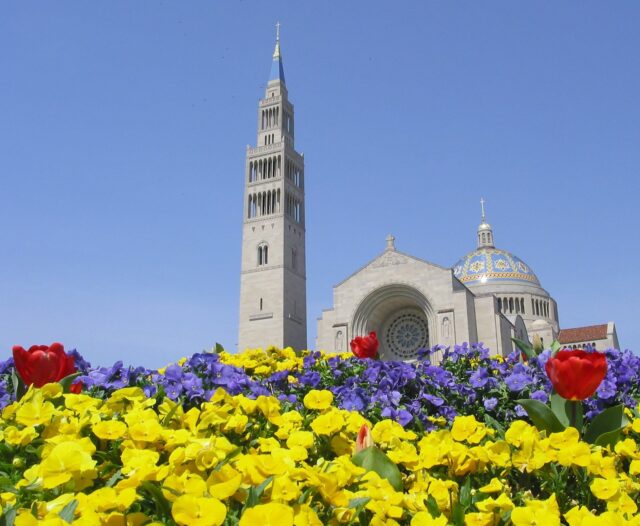
By Dana Villamagna, OSV News
While thousands of American families travel to the nation’s capital each year to tour historic and contemporary sites of government, Catholic families can also find many places in Washington that showcase our faith’s history and that highlight the many contributions great Catholics have made to America.
Start your visit at the St. John Paul II National Shrine in northeast Washington (3900 Harewood Road N.E.; www.jp2shrine.org). Opened in 2011 in the former home of the Pope John Paul II Cultural Center, the shrine was established by the Knights of Columbus to continue the pope’s mission and legacy. Pilgrims can learn about the life of St. John Paul II, from his upbringing in Poland to his 26-year papacy. The shrine offers opportunities for prayer and liturgy, as well as viewing art, cultural events and religious celebrations. The United States Conference of Catholic Bishops designated the Shrine a national shrine in 2014.
After visiting the center, walk a short distance past enchanting Marian gardens to the Basilica of the National Shrine of the Immaculate Conception (400 Michigan Ave. NE; www.nationalshrine.com). The size and beauty of the 77,500-square-foot basilica, one of the largest in the world, is breathtaking. Chapels in the basilica represent various cultures throughout the Catholic world. Construction began in the early 1900s and is still in progress. The basilica is located next to The Catholic University of America, a pontifical university in the United States and the only Catholic college founded by U.S. bishops.
Attending Mass in the District of Columbia can be a new cultural experience unto itself. Modern-day Washington boasts a thriving Catholic community. On any given Sunday, one can see the melting pot of America reflected in our very own faith community, with Mass spoken in 22 different languages. Visit the diocesan website, www.adw.org, to find a parish to visit.
Here are a few additional sites you may want to visit on your family’s next great American vacation:
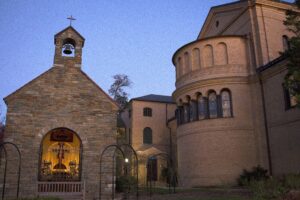
• The Franciscan Monastery: Walk through Roman-replica catacombs and Franciscan gardens. 1400 Quincy St. NE; https://myfranciscan.org.
• Chaplain’s Hill at Arlington National Cemetery: Pay respects to 83 Catholic chaplains from World War II, the Korean War and the Vietnam War at the Catholic Chaplain’s Monument, dedicated in 1989. Section 2 of Arlington National Cemetery, Arlington, Virginia; www.arlingtoncemetery.mil.
• Georgetown University: Explore the nation’s first Catholic University, founded by Jesuits in 1789. Stroll through the charm?ing Georgetown campus and adjacent neighborhood, where many diplomats and politicos live. 37th and O Streets NW.; www.georgetown.edu.
• St. Matthew’s Cathedral: Read the inscription carved into the floor at the site where President John F. Kennedy’s cas?ket was placed during his funeral, held at the cathedral Nov. 25, 1963. The cathedral, with magnificent mosaics on the walls and Italian design throughout, is on the National Register of Historic Places. 1725 Rhode Island Ave. NW; www.stmatthewscathedral.org.
• St. Patrick’s Catholic Church: Attend Mass at the oldest Catholic Church in the capital, founded in 1794 to minister to the needs of the stonema?sons building the White House and the U.S. Capitol. 619 10th St. NW; www.stpatrickdc.org.
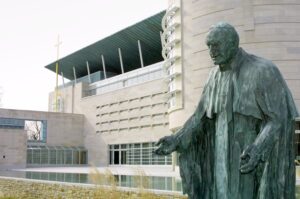
• St. Augustine Catholic Church: Visit the church known as the Mother Church of African-Americans, founded by freed slaves in 1865. 15th and V Streets NW. https://saintaugustine-dc.org/
Dana Villamagna writes widely, including on parenting and travel.
Bonus: A Catholic presence in the U.S. Capitol
Each year, an estimated 3 million to 5 million people who visit the U.S. Capitol can see great Catholics such as St. Damien of Molokai and Charles Carroll, one of the signers of the Declaration of Independence, represented in the National Statuary Hall Collection.
The collection, coordinated by the office of the Architect of the Capitol, is located throughout the capitol building. Each state chooses subjects, commissions and pays for two statues to give to the collection, which represents notable Americans from all walks of life, from great statesmen such as George Washington to memorable entertainers like Will Rogers. The collection contains 99 statues of great Americans. (Virginia has a vacancy after removing a statue of Robert E. Lee in 2020.)
A number of states have chosen Catholic missionaries, educators and social activists to represent them in the collection. Some of the most notable are listed below:
Arizona’s Father Eusebio Kino is honored with a statue in the collection for his work with the Pima Indians, and for establishing many missions and rancheras in the West. Father Kino, born in Italy, joined the Jesuits in 1665 and died in 1711.
California’s St. Junipero Serra was a Franciscan Spanish missionary to the new world. He founded many missions, including San Diego, San Antonio, San Francisco and San Luis Obispo.
St. Damien of Molokai’s statue in the capitol is a modern representation depicting him with the marks of leprosy, which took his life in 1889 after his many years on the Hawaiian island of Molokai serving the lepers sent to live there in exile.
Charles Carroll of Carrollton is honored by Maryland as a political activist in the colonies. As a Catholic, Carroll was initially barred from entering politics, practicing law or voting. He later signed the Declaration of Independence. He died in 1832, the last surviving signer of that document.
Washington state honors Mother Joseph, Canadian-born Esther Pariseau, who in 1856 led missionaries to the Pacific Northwest to build schools, hospitals and orphanages. The American Institute of Architects declared her the First Architect of the Pacific Northwest.
Wisconsin chose Father Jacques Marquette to represent it in the collection. Father Marquette was a Jesuit missionary and an explorer of the Mississippi River. The largest Catholic university in Wisconsin is named after Father Marquette.
For more information about the National Statuary Hall Collection and about the sculptors who created the statues, visit the office of the Architect of the Capitol’s website at visit www.aoc.gov.





